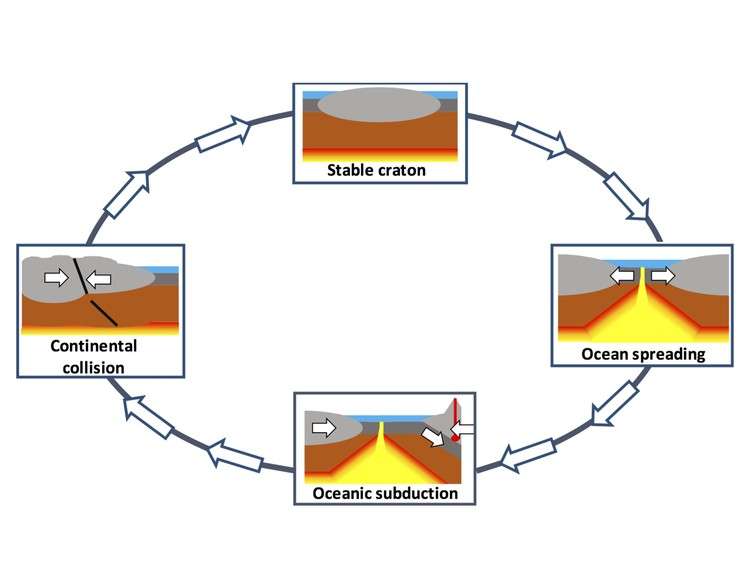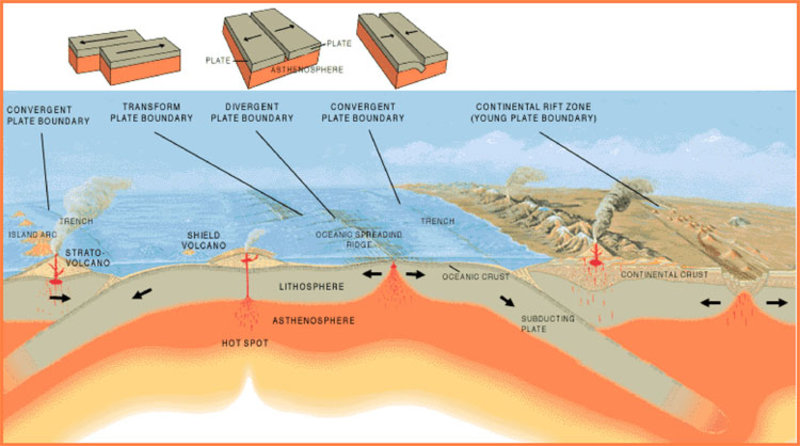Describe the Process of Plate Tectonics
Tectonics comes from the Greek word meaning builder The movement of the plates toward or away from each other either di View the full answer. The process of plate tectonics may be driven by convection in Earths mantle the pull of heavy old pieces of crust into the mantle or some combination of both.

Brief History Of The Plate Tectonics Theory Earth Observatory Of Singapore
Subduction happens where tectonic plates crash into each other instead of spreading apart.

. Divergent Boundary- It occurs when two plates move apart from each other. Convergent boundary is one in which one plate Oceanic Plate subducts beneath another plate Oceanic Continental plate due to difference in density of the plates. The Theory of Plate Tectonics.
The theory of plate tectonics describes the motion of Earths plates and their role in geological processes such as mountain building earthquakes and volcanoes. Describe the process of Sea-Floor Spreading. Oceanic and continental plates come together spread apart and interact at boundaries all over the planet.
The Earths lithosphere which includes the crust and upper mantle is made up of a series of pieces or tectonic plates that move slowly over time. This takes place at the deep sea trenches. Start studying Plate Tectonics.
The outer limbs of the convection cells plunge down into the deeper mantle dragging oceanic crust as well. Plate tectonic theory is in fact the. Plate tectonics is the scientific theory explaining the movement of the earths crust.
Plate tectonics is a scientific theory that explains how major landforms are created as a result of Earths subterranean movements. Earths internal processes were previously thought to operate in a vertical fashion with continents oceans and mountain ranges bobbing up and down without much sideways movement. These fragments are suspended on the asthenosphere which is molten hence offering good medium of movement.
When the two plates separate there is a rising lava in the middle due to the convection current and when the magma rises it will solidify and a new plate will be formed. Plate tectonics has revolutionized the way we view large features on the surface of the Earth. Tectonicus from the Ancient Greek.
Plate tectonics requires plates to be rigid and deform at the edges they are strong enough that a force acting on one part of the plate pushes the entire plate. Along these boundaries earthquakes are common and magma molten rock rises from the Earths mantle to the surface solidifying to create. Plate tectonics describes the movement of fragments formed from broken lithosphere.
A divergent boundary occurs when two tectonic plates move away from each other. Features like island arc oceanic trench mountain ranges are formed in this boundary. For a deeper discussion of plate-driving mechanisms see Plate-driving mechanisms and the role of the mantle.
The theory of plate tectonics states that the Earths solid outer crust the lithosphere is separated into plates that move over the asthenosphere the molten upper portion of the mantle. The movement of these tectonic plates is likely caused by convection currents in the molten rock in Earths mantle below the crust. Seafloor spreading creates new crust.
There are three different types of plate tectonics that is convergent divergent and lateral slipping. Plate tectonics from the Late Latin. Earthquakes and volcanoes are the direct result of the movement of tectonic plates at fault lines.
This immense mountain range began to form between 40 and 50 million years ago when two large landmasses India and Eurasia driven by plate movement collided and because both these continental landmasses have about the same rock density one plate could not be sub-ducted under the other. The material sinks to the core and moves horizontally. The basic theory of plate tectonics is that along seafloor spreading zones the continents are separating from one another.
The theory belongs to a host of scientists of different disciplines. Plate tectonics is the geologic theory that Earths crust is made up of rigid plates that float on the surface of the planet. There are two sets of forces created at the edge of oceanic plates one where they are created and another when they destroyed.
Mountain building folding and faulting continental drift vulcanicity seismic events earthquakes etc. Learn vocabulary terms and more with flashcards games and other study tools. Enumerate and discuss the different processes that occur along plate boundaries.
In plate tectonics Earths outermost layer or lithosphere. As the tectonic plates move away from spreading zones they collide with one another. The denser lithospheric material then melts back into the Earths mantle.
Earthquakes and volcanoes are the short-term results of this tectonic movement. The top limb of the convection cell moves horizontally away from the ridge crest as does the new seafloor. Pertaining to building is the generally accepted scientific theory that considers the Earth s lithosphere to comprise a number of large tectonic plates which have been slowly moving since about 34 billion years ago.
The major plate tectonic processes are Convergent divergent and transformshear stress that lead to formation of following boundary. At subduction zones the edge of the denser plate subducts or slides beneath the less-dense one. Most of the earthquakes and volcanoes around the Pacific ocean basina pattern known as the ring of fire.
As discussed about in both the circumstances basic principle of plate. What is the process of plate tectonics. The formation of new oceanic crust by the movement of magma out of the mid-ocean ridge causing the sea floor to widen over time.
Diagram of ridge push httpwwwcolumbiaeduvjd1driving_forces_basichtm. At an oceaniccontinental convergence the melt rises to form volcanic mountainsa volcanic arcon the overlying continental crust. Each tectonic plate is free-floating and can move independently.
The theory which solidified in the 1960s transformed the earth sciences by explaining many phenomena including mountain building events volcanoes and earthquakes. As they spread apart magma comes to the surface and becomes new continental crust. Plate tectonic theory is a comprehensive theory which offers explanations for various relief features and tectonic events viz.
The term fault is used to describe the boundary between tectonic plates. Plate tectonics is the theory that Earths outer shell is divided into large slabs of solid rock called plates that glide over Earths mantle the rocky inner layer above Earths core. Divergent boundary produces rift.

Tectonic Forces Nasa Space Place Nasa Science For Kids

Oregon A Geologic History The Big Picture Plate Tectonics And Hot Spots

What Causes Tectonic Plates To Move Worldatlas

Plate Tectonics New Findings Fill Out The 50 Year Old Theory That Explains Earth S Landmasses
Plate Tectonic Theory The British Geographer

The Relationship Between Igneous Rocks Tectonic Plates

Plate Tectonics Seafloor Spreading Britannica

The Theory Of Plate Tectonics Geology

What Causes Tectonic Plates To Move Worldatlas

Orange Peel Plate Tectonics Geology For Kids

Plate Tectonics Understanding Global Change

Plate Tectonics Definition Theory Types Facts Evidence

What Are The Different Types Of Plate Tectonic Boundaries Exploration Facts Noaa Office Of Ocean Exploration And Research
Plate Tectonic Theory The British Geographer

Flow Chart Outlining Staglab S Plate Tectonics Diagnostic Procedure Download Scientific Diagram

Plate Tectonics And Volcanism Eskp

Plate Tectonics Tectonics Plate Movements Plate Tectonic Theory


Comments
Post a Comment